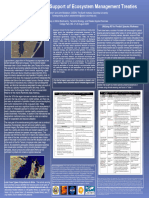Cover Page
Cover Page
Uploaded by
krishnakarthikm10Copyright:
Available Formats
Cover Page
Cover Page
Uploaded by
krishnakarthikm10Copyright
Available Formats
Share this document
Did you find this document useful?
Is this content inappropriate?
Copyright:
Available Formats
Cover Page
Cover Page
Uploaded by
krishnakarthikm10Copyright:
Available Formats
Cover Page
Title: The Role of GIS in Marine Biology: Tracking, Analyzing, and Conserving Marine Ecosystems
Your Name
Institution/School Name
Date of Submission
2. Abstract
Geographic Information Systems (GIS) have revolutionized marine
biology by enabling scientists to collect, analyze, and visualize spatial
data about the world’s oceans and marine life. This project
investigates the applications of GIS in tracking marine species,
analyzing habitat conditions, and supporting conservation efforts. By
examining case studies on sea turtle migration, coral reef
monitoring, and Marine Protected Area (MPA) planning, this project
highlights how GIS contributes to understanding and preserving
ocean ecosystems. Key findings show that GIS enhances data-driven
decision-making, supports sustainable conservation, and offers
actionable insights into species protection and habitat conservation.
Despite some challenges, such as high technology costs and data
gaps, GIS remains indispensable in advancing marine biology and
guiding future marine conservation efforts.
3. Introduction
What is GIS?
Geographic Information Systems (GIS) are tools that capture, store,
analyze, and display spatial or geographic data. GIS can map data
layers to show relationships, patterns, and trends across different
regions. In marine biology, GIS is critical for organizing and visualizing
complex data on marine species, habitats, and ecosystems. Through
satellite data, GPS tracking, and environmental data layers, GIS aids
scientists in understanding the distribution and behavior of marine
life and the impacts of environmental changes.
Importance of GIS in Marine Biology
Marine ecosystems face significant pressures from climate change,
pollution, overfishing, and habitat destruction. To manage and
protect these ecosystems effectively, marine biologists require
accurate, spatially-relevant data. GIS provides a platform to track
species migration, assess habitat health, and develop conservation
strategies based on real-time data. By visualizing oceanographic
information alongside species distribution, GIS enables researchers
to assess threats, plan interventions, and monitor ecosystem
responses over time.
Scope and Objectives
This project aims to explore:
1. The application of GIS in tracking marine species.
2. GIS’s role in analyzing marine habitats and environmental
impacts.
3. The importance of GIS in marine conservation, particularly in
MPA planning and management.
4. Literature Review
Review of GIS in Marine Biology Research
GIS applications in marine biology are well-documented. Numerous
studies demonstrate how GIS aids in tracking marine species and
managing ecosystems. For instance, GIS has been used to map global
coral reef health, helping scientists predict areas at risk of coral
bleaching due to rising sea temperatures. Similarly, GIS allows for
tracking the migratory patterns of sea turtles and whales, providing
insights into key feeding and breeding grounds and informing MPA
designation.
Advances in GIS Technology for Marine Biology
Recent advancements have transformed GIS’s role in marine biology.
Satellite imaging from NOAA and NASA provides high-resolution data
on oceanic conditions such as temperature and chlorophyll levels,
essential for monitoring marine habitats. Other advancements
include GPS-enabled tracking devices for species, drone surveillance,
and even underwater sensors that provide real-time data on species
movements and environmental changes. These technologies allow
GIS to create dynamic models and predictive analytics that anticipate
marine biodiversity shifts.
5. Methodology
Data Collection
1. Satellite Data: Organizations like NOAA and NASA supply
satellite data on sea surface temperature, chlorophyll
concentration, and other vital parameters. This data helps
researchers analyze environmental conditions impacting
marine habitats and species distribution.
2. GPS Tracking for Marine Species: Many marine animals, like
sea turtles and sharks, are tagged with GPS devices to record
their movements. GIS then processes this data to map
migratory routes, identify critical habitats, and observe
behavioral patterns under environmental stress.
3. Ecological Data: GIS can also incorporate oceanographic
information, such as ocean currents, seabed topography, and
vegetation types, which are crucial for understanding marine
ecosystems and habitat preferences.
Data Analysis Using GIS Software
GIS software, such as ArcGIS and QGIS, allows users to analyze spatial
data by creating layered maps that combine various datasets. Spatial
analysis techniques within GIS help researchers identify patterns in
species distribution, migration paths, and habitat usage. Layers of
data can be superimposed to assess factors influencing species
distribution and habitat health.
Data Visualization
Data visualization is a critical aspect of GIS in marine biology. By
creating maps, 3D models, and other visual representations, GIS
enables scientists and policymakers to communicate findings
effectively. These visualizations provide insights into marine
ecosystem dynamics and help communicate complex data to broader
audiences, including conservation agencies and local communities.
6. Case Studies
Case Study 1: Tracking Sea Turtle Migrations
Sea turtles migrate over vast distances between feeding and
breeding grounds. By tagging turtles with GPS, researchers track
migration routes, identifying crucial areas for protection. GIS
processes the tracking data and overlays it with environmental
factors like water temperature and food availability, helping
scientists understand the impact of environmental changes on
migration. For example, GIS revealed that certain nesting beaches
require protection during specific months, leading to seasonal
restrictions on human activities in these areas.
Case Study 2: Coral Reef Health Monitoring
Coral reefs are sensitive to temperature changes and other
environmental stressors. Using GIS, scientists can map coral reefs
globally, monitor bleaching events, and predict which reefs are at
higher risk. Satellite data on sea temperatures are overlaid on reef
locations to identify bleaching hotspots, where conservation efforts
are then prioritized. The Great Barrier Reef, for instance, has been
extensively monitored using GIS, which helps track the health of
coral populations and measure the effectiveness of conservation
initiatives over time.
Case Study 3: Marine Protected Area (MPA) Planning
MPAs are designed to protect biodiversity, manage fishing, and
maintain ecosystem health. GIS supports MPA planning by providing
comprehensive spatial data that incorporates species diversity,
human impact zones, and ecological features. For instance, GIS
analysis was used to design MPAs along the coast of California by
mapping areas critical for endangered species, identifying zones with
minimal human activity, and ensuring connectivity between habitats.
This spatial approach maximizes conservation impact while balancing
economic activities like fishing.
7. Results and Discussion
Impact of GIS on Conservation Efforts
GIS enables targeted, data-driven conservation strategies. It allows
for more effective resource allocation, protecting areas with high
biodiversity or those under the most threat. Case studies show that
GIS data informs MPA design, assists in habitat restoration, and
supports species protection. The accessibility of GIS maps for
different stakeholders also encourages collaborative conservation
efforts, involving both governments and communities.
Limitations and Challenges
GIS has limitations, especially in marine settings:
Cost of Technology: GIS software, satellite data, and GPS
tagging are costly, making them inaccessible to some research
organizations and countries with limited resources.
Data Gaps and Inaccuracies: Satellite and GPS data are often
limited in remote ocean regions. Uncertain or outdated data
can lead to inaccuracies in modeling and analysis.
Data Sharing and Privacy: Access to sensitive data, like
endangered species locations, needs to be controlled to
prevent exploitation while ensuring it’s available for research
and conservation.
Future Directions
Future GIS advancements in marine biology will likely involve real-
time tracking, AI-based data analysis, and increased use of predictive
models. These technologies can anticipate shifts in marine
biodiversity due to climate change or human impact, enabling
proactive conservation. Collaborative data-sharing networks among
nations will also likely improve GIS applications for global marine
ecosystem protection.
8. Conclusion
GIS is an invaluable tool in marine biology, aiding in tracking species,
monitoring habitats, and planning conservation efforts
You might also like
- GeoDocument14 pagesGeokrishnakarthikm10No ratings yet
- Title PageDocument12 pagesTitle Pagekrishnakarthikm10No ratings yet
- 148Document15 pages148deniNo ratings yet
- Sample Specific applications of GIS and RS (Support Notes)Document12 pagesSample Specific applications of GIS and RS (Support Notes)kiptoo.bethwel21No ratings yet
- Applications of GPSDocument4 pagesApplications of GPSAdityaNo ratings yet
- Assignment 2 (MSDI)Document7 pagesAssignment 2 (MSDI)Adila IshakNo ratings yet
- Madda Walabu University College of Computing Department of Information TechnologyDocument5 pagesMadda Walabu University College of Computing Department of Information Technologynebiyutora566No ratings yet
- Title Pag1Document21 pagesTitle Pag1krishnakarthikm10No ratings yet
- Remote SensingDocument3 pagesRemote SensingVinu JohnNo ratings yet
- Jurnal SIGDocument13 pagesJurnal SIGAsmoro Pribadi DewoNo ratings yet
- Sea Stats GIS Remote SensingDocument4 pagesSea Stats GIS Remote SensingFlorida Fish and Wildlife Conservation CommissionNo ratings yet
- Madda Walabu University College of Computing Department of Information TechnologyDocument4 pagesMadda Walabu University College of Computing Department of Information Technologynebiyutora566No ratings yet
- GIS RevirewDocument4 pagesGIS Revirewnebiyutora566No ratings yet
- Applications of Remote Sensing and GISDocument6 pagesApplications of Remote Sensing and GISVedika GoelNo ratings yet
- Towards Marine Spatial Planning Plan For The Sustainable Management of The SeaDocument1 pageTowards Marine Spatial Planning Plan For The Sustainable Management of The SeaStelios AgapiouNo ratings yet
- Predicting Cetacean Distributions in The ENA To Support Marine ManagementDocument16 pagesPredicting Cetacean Distributions in The ENA To Support Marine ManagementÁgatha GilNo ratings yet
- Time Series Analysis For Monitoring Seagrass HabitDocument8 pagesTime Series Analysis For Monitoring Seagrass Habitnapat.tampaNo ratings yet
- Spatial Databases Play a Critical Role in Geographic Information SystemsDocument10 pagesSpatial Databases Play a Critical Role in Geographic Information SystemssunshineropanianagallardoNo ratings yet
- Fmars 10 1213689Document3 pagesFmars 10 1213689Danial AsnawiNo ratings yet
- MQ Quaid Et Al 2023Document20 pagesMQ Quaid Et Al 2023Alvar CarranzaNo ratings yet
- GIS For The OceansDocument94 pagesGIS For The OceansEsriNo ratings yet
- Cruz-Garcia Etal JCCDocument11 pagesCruz-Garcia Etal JCCalejandroNo ratings yet
- Current Issues, Status and Applications of GIS To Marine FisheriesDocument33 pagesCurrent Issues, Status and Applications of GIS To Marine FisheriesKyran Joeffer EsporlasNo ratings yet
- High-resolution optical remote sensing geomorphological mapping of coral Pereira - 2023Document15 pagesHigh-resolution optical remote sensing geomorphological mapping of coral Pereira - 2023Leonardo BuenoNo ratings yet
- Assignment Gis and Rs TrueDocument29 pagesAssignment Gis and Rs TrueTheSad EmoticonNo ratings yet
- Unlocking Ecological Insights With Geospatial DatasetsDocument5 pagesUnlocking Ecological Insights With Geospatial Datasetswhitney cheroNo ratings yet
- TFG Pau Baquin DefinitiuDocument31 pagesTFG Pau Baquin DefinitiuPau BarquinNo ratings yet
- CONSERVACIONDocument84 pagesCONSERVACIONJO VENo ratings yet
- Complex Draf ReportDocument8 pagesComplex Draf Reportanjilakanwar13No ratings yet
- List of Uses of GIS in Water ResourcesDocument3 pagesList of Uses of GIS in Water ResourcesSam SukumarNo ratings yet
- Ocean & Coastal ManagementDocument9 pagesOcean & Coastal ManagementsyahaliNo ratings yet
- 199 328 Ab PresDocument1 page199 328 Ab PresshrawwilNo ratings yet
- Modern Applications of GeologyDocument11 pagesModern Applications of GeologyMisty TinggalenNo ratings yet
- Analise Bibliometrica Como Estrategia de Suporte ADocument30 pagesAnalise Bibliometrica Como Estrategia de Suporte AYasmim LucenaNo ratings yet
- Practicum I Pau Barquin DefinitiuDocument11 pagesPracticum I Pau Barquin DefinitiuPau BarquinNo ratings yet
- TMP 9 A03Document16 pagesTMP 9 A03FrontiersNo ratings yet
- S Patio Temporal AnalysisDocument27 pagesS Patio Temporal AnalysisKunle KunleNo ratings yet
- Remote Sensing 6Document7 pagesRemote Sensing 6abheetpethe.scoe.entcNo ratings yet
- GIS Application in Watershed ManagementDocument7 pagesGIS Application in Watershed Managementjafar cad100% (1)
- Applications of GisDocument10 pagesApplications of Gismehak parasharNo ratings yet
- Esri Conservation Map Book, July 2011Document84 pagesEsri Conservation Map Book, July 2011EsriNo ratings yet
- Monitoring and Modelling of Shoreline CHDocument9 pagesMonitoring and Modelling of Shoreline CHsatyakali24No ratings yet
- Assessment of Shoreline Changes OfalibagDocument7 pagesAssessment of Shoreline Changes Ofalibagsatyakali24No ratings yet
- Journal of Environmental Management: Elizabeth M. de SantoDocument10 pagesJournal of Environmental Management: Elizabeth M. de Santot.ethan35No ratings yet
- Fish 1Document7 pagesFish 1Zachariah OverauxNo ratings yet
- AbstractDocument2 pagesAbstractlapislazuliblue2806No ratings yet
- 005 Coral Reef Mapping With Remote Sensing and Machine Learning A Nurture and Nature Analysis in Marine Protected AreasDocument26 pages005 Coral Reef Mapping With Remote Sensing and Machine Learning A Nurture and Nature Analysis in Marine Protected AreasVINESSE JUMAWIDNo ratings yet
- CHAPTER 1 Latest RalphADocument60 pagesCHAPTER 1 Latest RalphANicole Divine Grace BaliquigNo ratings yet
- Multi-Dimensional Evaluation and Ranking of Coastal Areas Using GIS and Multiple Criteria Choice MethodsDocument17 pagesMulti-Dimensional Evaluation and Ranking of Coastal Areas Using GIS and Multiple Criteria Choice MethodsHeni SusiatiNo ratings yet
- Analyzing Coastal Vulnerability Index Using IntegrDocument7 pagesAnalyzing Coastal Vulnerability Index Using IntegrPrayogiNo ratings yet
- Oceans PDFDocument94 pagesOceans PDFDaniel CadenaNo ratings yet
- Invasive Species Management and Research Using Gis: Digitalcommons@University of Nebraska - LincolnDocument8 pagesInvasive Species Management and Research Using Gis: Digitalcommons@University of Nebraska - LincolnrockfestNo ratings yet
- Fmars 07 594636Document12 pagesFmars 07 594636Luz Erandi Saldaña RuizNo ratings yet
- Applications of GIS Analysis For Natural Resource Management at The National Biological Service's Southern Science CenterDocument7 pagesApplications of GIS Analysis For Natural Resource Management at The National Biological Service's Southern Science CenterJayachandran NellikuppamNo ratings yet
- TMP 590 FDocument15 pagesTMP 590 FFrontiersNo ratings yet
- Ges Assigment 1Document6 pagesGes Assigment 1Nelwamondo Ampfarisaho Andy DeepsixNo ratings yet
- 14487-Article Text-1084012-1-10-20230608Document10 pages14487-Article Text-1084012-1-10-20230608Strawberry PaiNo ratings yet
- NW Siquijor Biodiversity SurveyFINALDocument14 pagesNW Siquijor Biodiversity SurveyFINALENRMO LCCNo ratings yet
- Fmars 2017 00107Document14 pagesFmars 2017 00107izzy officialNo ratings yet
- The Fragmented Forest: Island Biogeography Theory and the Preservation of Biotic DiversityFrom EverandThe Fragmented Forest: Island Biogeography Theory and the Preservation of Biotic DiversityNo ratings yet
- Atlas of Major Ichnological FormsDocument27 pagesAtlas of Major Ichnological Formsjosue umatamboNo ratings yet
- The Sea Book (Charlotte Milner) (Z-Library)Document50 pagesThe Sea Book (Charlotte Milner) (Z-Library)Archana SNo ratings yet
- 2022 04 DMSD Modifikasi Dan Degradasi HabitatDocument34 pages2022 04 DMSD Modifikasi Dan Degradasi HabitatRiangga Afif AmrullohNo ratings yet
- 310 - PDFsam - Visualizing Environmental Science - 5th Ed - (2017)Document1 page310 - PDFsam - Visualizing Environmental Science - 5th Ed - (2017)sukardi sudionoNo ratings yet
- EVS Assignment (PN)Document4 pagesEVS Assignment (PN)chandrikamittal228No ratings yet
- Icrm PlanDocument79 pagesIcrm PlanJhalian Del RosarioNo ratings yet
- Marine Biology Literature ReviewDocument4 pagesMarine Biology Literature Reviewlqinlccnd100% (1)
- Types of Ecosystem – Ecosystem Structures & FunctionsDocument23 pagesTypes of Ecosystem – Ecosystem Structures & Functionslikekeke3No ratings yet
- Get Ocean Studies Introduction to Oceanography Fourth Edition Douglas A. Segar free all chaptersDocument55 pagesGet Ocean Studies Introduction to Oceanography Fourth Edition Douglas A. Segar free all chaptersbaryssabolvk86% (7)
- Full (Ebook PDF) Marine Biology 11th Edition by Peter Castro Ebook All ChaptersDocument51 pagesFull (Ebook PDF) Marine Biology 11th Edition by Peter Castro Ebook All Chaptersalviiaghati100% (8)
- Oso 9780199498734 Chapter 29Document23 pagesOso 9780199498734 Chapter 29Abhishikta DasNo ratings yet
- Download full Essentials of oceanography 6th ed Edition Garrison ebook all chaptersDocument60 pagesDownload full Essentials of oceanography 6th ed Edition Garrison ebook all chapterskuzakdagnyhu100% (12)
- Download ebooks file (eBook PDF) Marine Ecology: Processes, Systems, and Impacts 3rd Edition all chaptersDocument45 pagesDownload ebooks file (eBook PDF) Marine Ecology: Processes, Systems, and Impacts 3rd Edition all chaptersnkukzadaging100% (1)
- snorkelers-guide-to-plants-and-animals-genDocument28 pagessnorkelers-guide-to-plants-and-animals-gensummerfaethepsychicNo ratings yet
- Marine EcosystemDocument16 pagesMarine Ecosystemmary grace callaoNo ratings yet
- Aquatic Ecosystems - (Ponds, Streams, Lakes, Rivers, Oceans, Estuaries)Document21 pagesAquatic Ecosystems - (Ponds, Streams, Lakes, Rivers, Oceans, Estuaries)vardhanharsh241No ratings yet
- Living Shorelines The Science and Management of Nature Based Coastal Protection 1st Edition Donna Marie Bilkovic 2024 Scribd DownloadDocument62 pagesLiving Shorelines The Science and Management of Nature Based Coastal Protection 1st Edition Donna Marie Bilkovic 2024 Scribd Downloadwadonepuxi100% (3)
- Dsu 206 Biogeography and Climate of East Africa-1Document102 pagesDsu 206 Biogeography and Climate of East Africa-1tommbuvi005No ratings yet
- Mapping Cumulative Indicators Nceas 12Document109 pagesMapping Cumulative Indicators Nceas 12brisingrghostNo ratings yet
- RC LP Marine Waters UpdatedDocument7 pagesRC LP Marine Waters UpdatedRafael ConstantinoNo ratings yet
- Survey of Flora of Coastal Karnataka - Mangroves1Document14 pagesSurvey of Flora of Coastal Karnataka - Mangroves1Adharva SagaraNo ratings yet
- Marine Biodiversity and Ecosystem FunctioningDocument101 pagesMarine Biodiversity and Ecosystem FunctioningDarshan JagtapNo ratings yet
- Science 6_2nd Quarter Final RUQADocument6 pagesScience 6_2nd Quarter Final RUQADagoc Wil Jr.No ratings yet
- English 4 Lesson 5 Week 5Document16 pagesEnglish 4 Lesson 5 Week 5corypaleyan14No ratings yet
- Fishes out of water : biology and ecology of mudskippers 1st Edition Zeehan Jaafar 2024 Scribd DownloadDocument55 pagesFishes out of water : biology and ecology of mudskippers 1st Edition Zeehan Jaafar 2024 Scribd Downloadarmescomanf8100% (1)
- Biology ss2 First TermDocument42 pagesBiology ss2 First TermFrancis Adebayo Adeapin (ACTUALIZER)No ratings yet
- Types of HabitatsDocument12 pagesTypes of Habitatscomfortgaye56No ratings yet
- Malandog Final Report (Survey & Mapping of Existing Coastal Use)Document18 pagesMalandog Final Report (Survey & Mapping of Existing Coastal Use)Daniel ElemiaNo ratings yet
- Marine Biology Dissertation IdeasDocument5 pagesMarine Biology Dissertation IdeasPayToDoPaperSingapore100% (2)
- Final Revision Paper of Seagrass ThesisDocument23 pagesFinal Revision Paper of Seagrass ThesisJuvy Ann ErongNo ratings yet

























































































